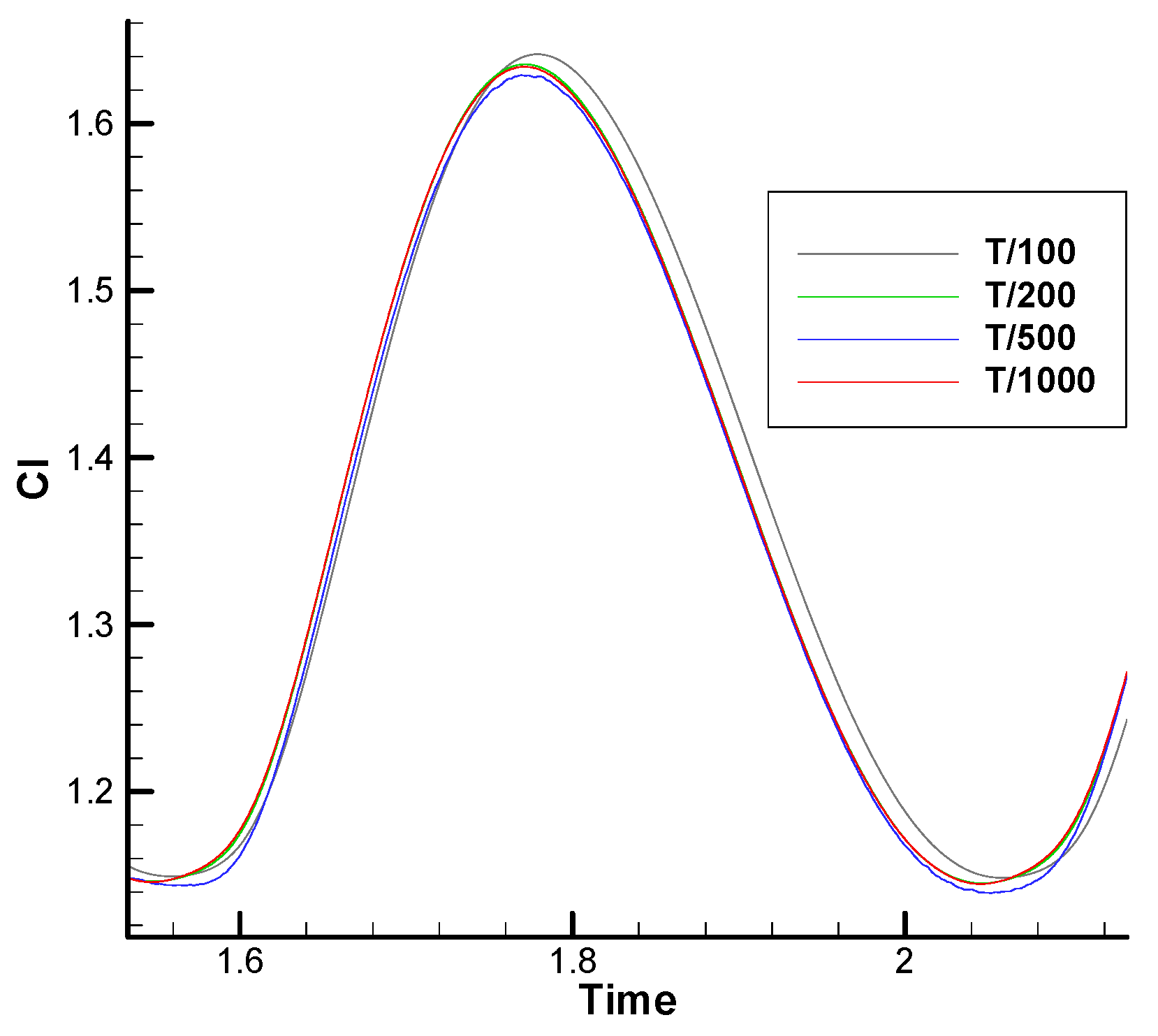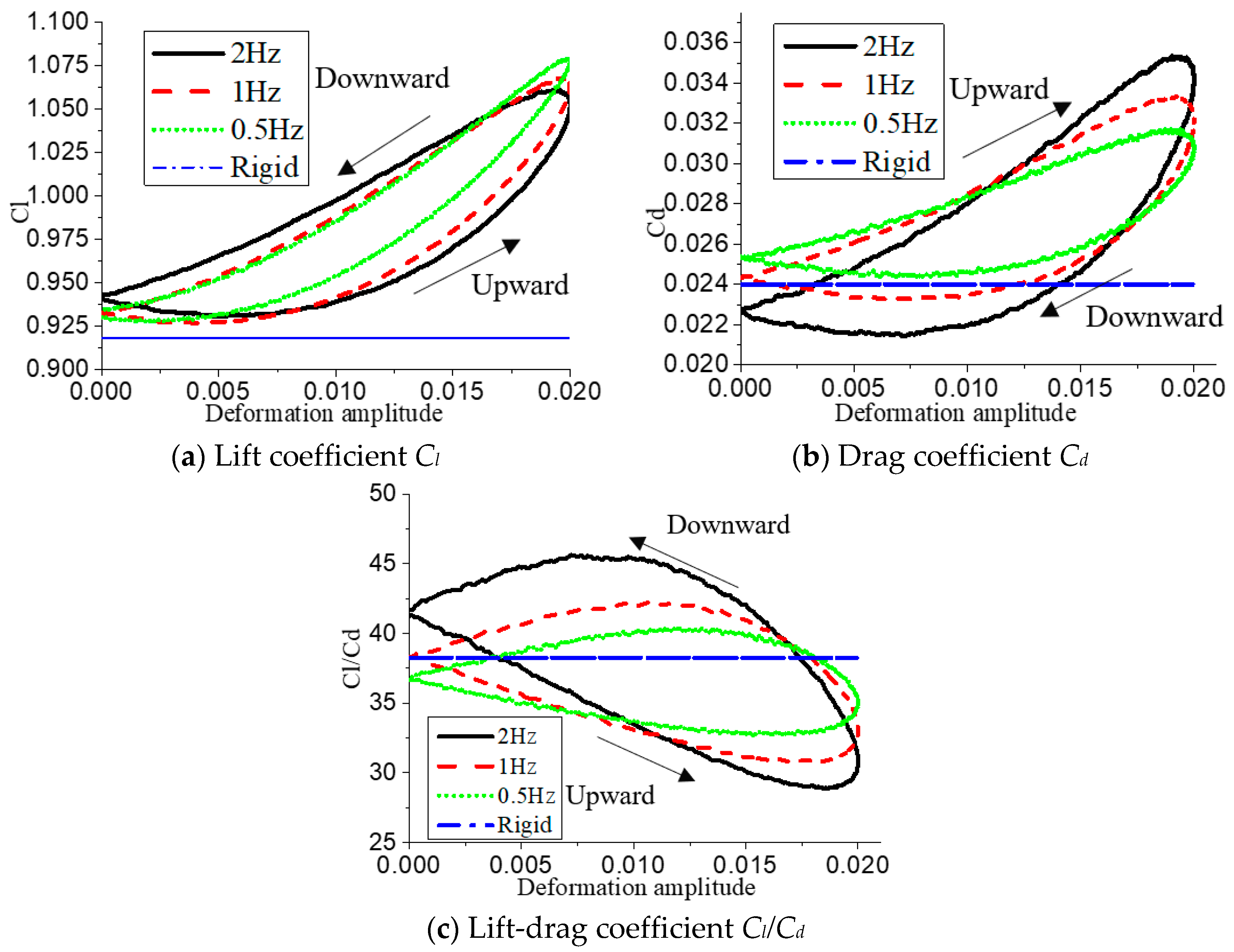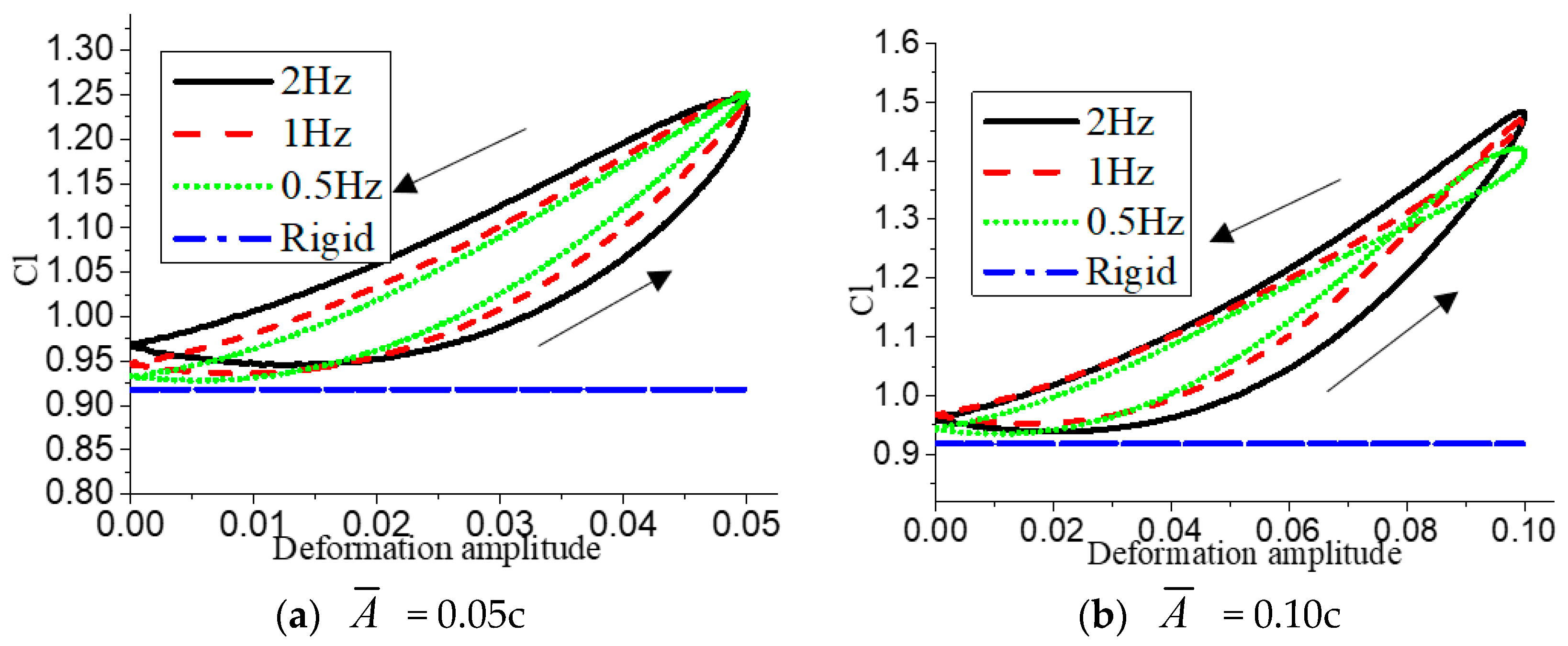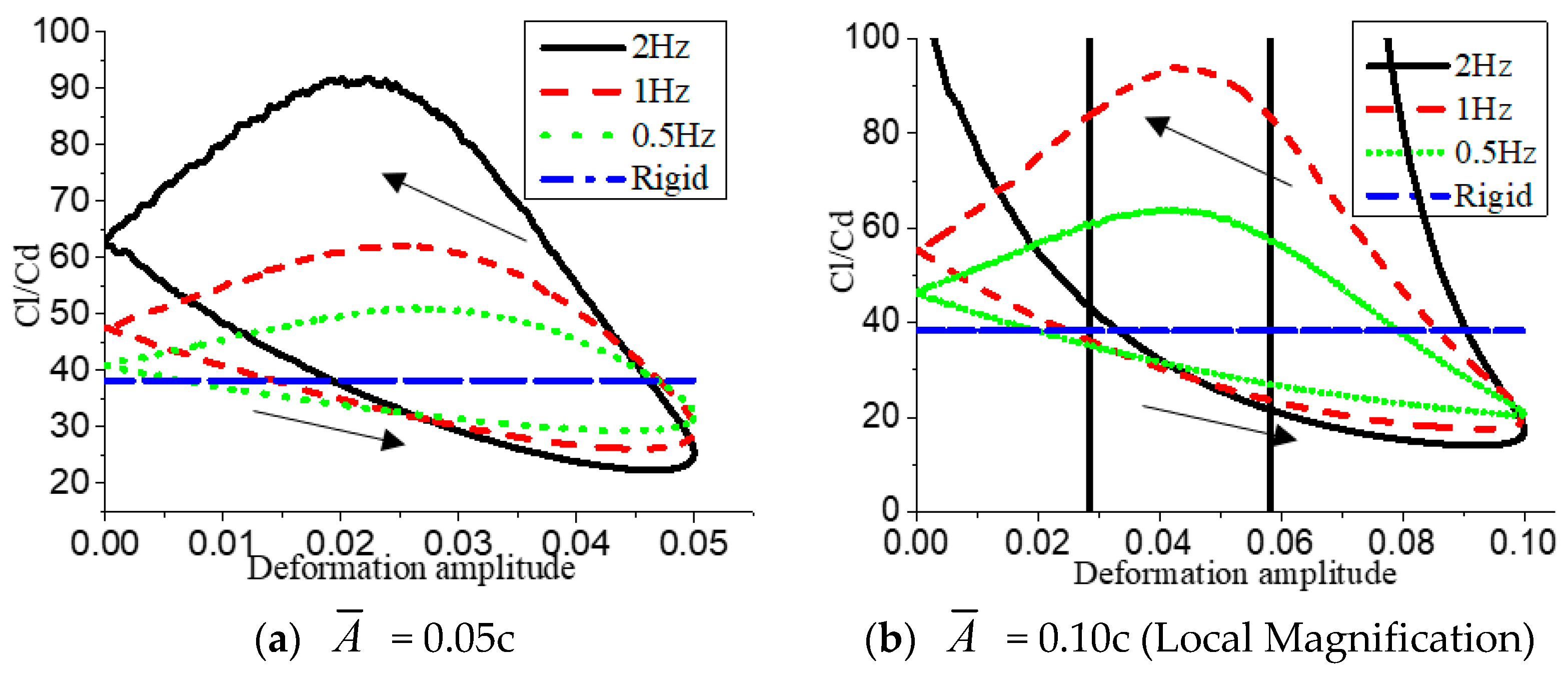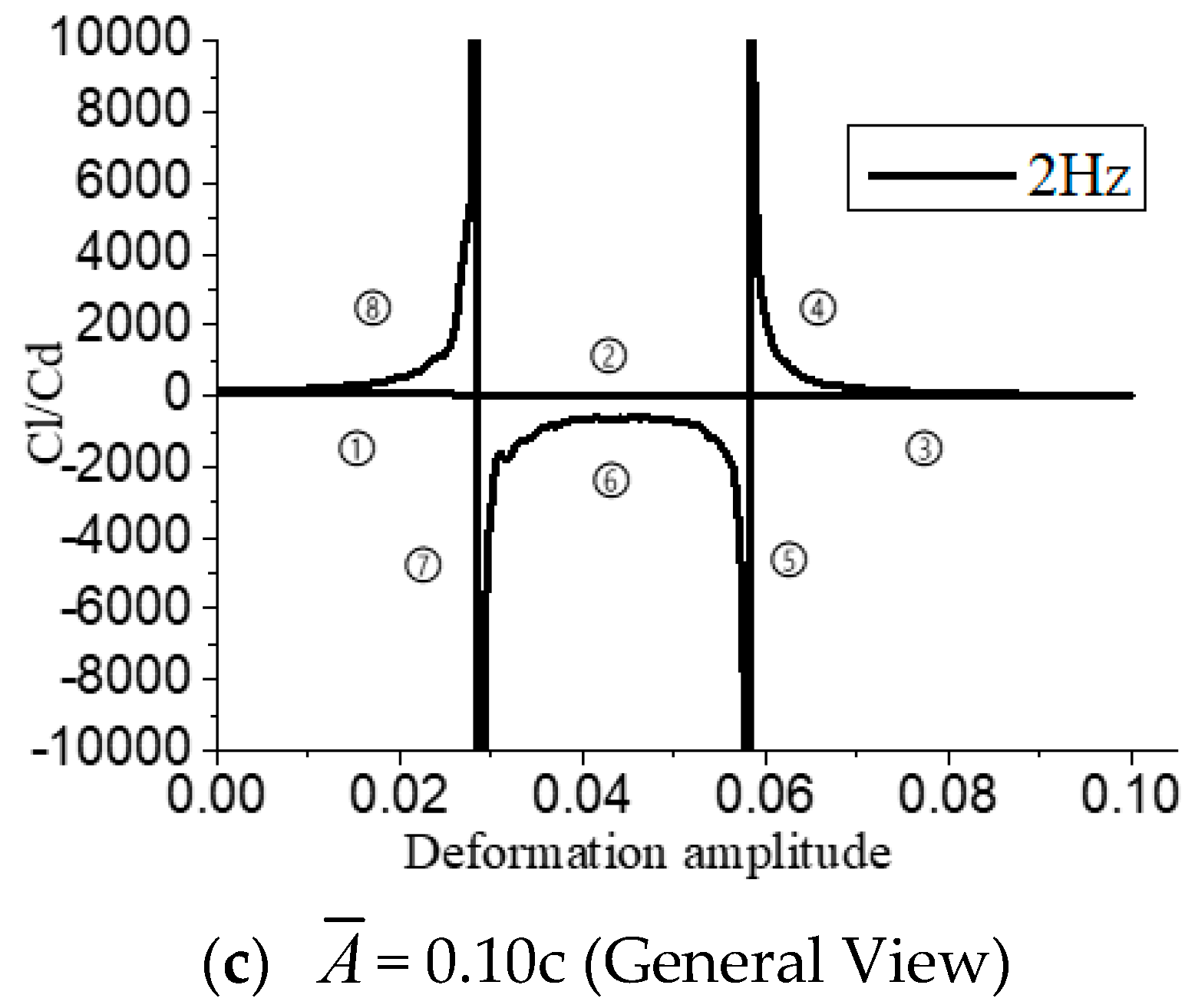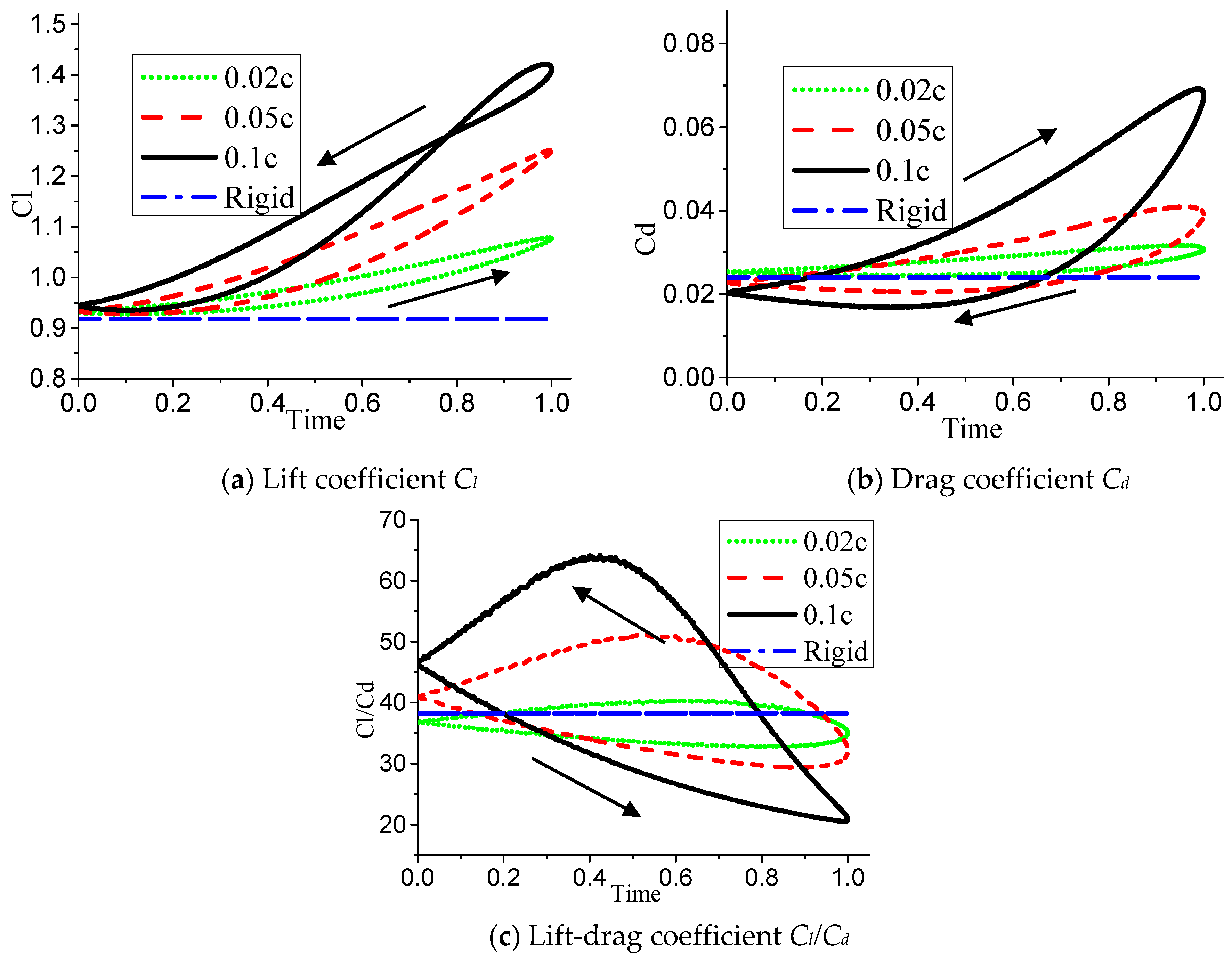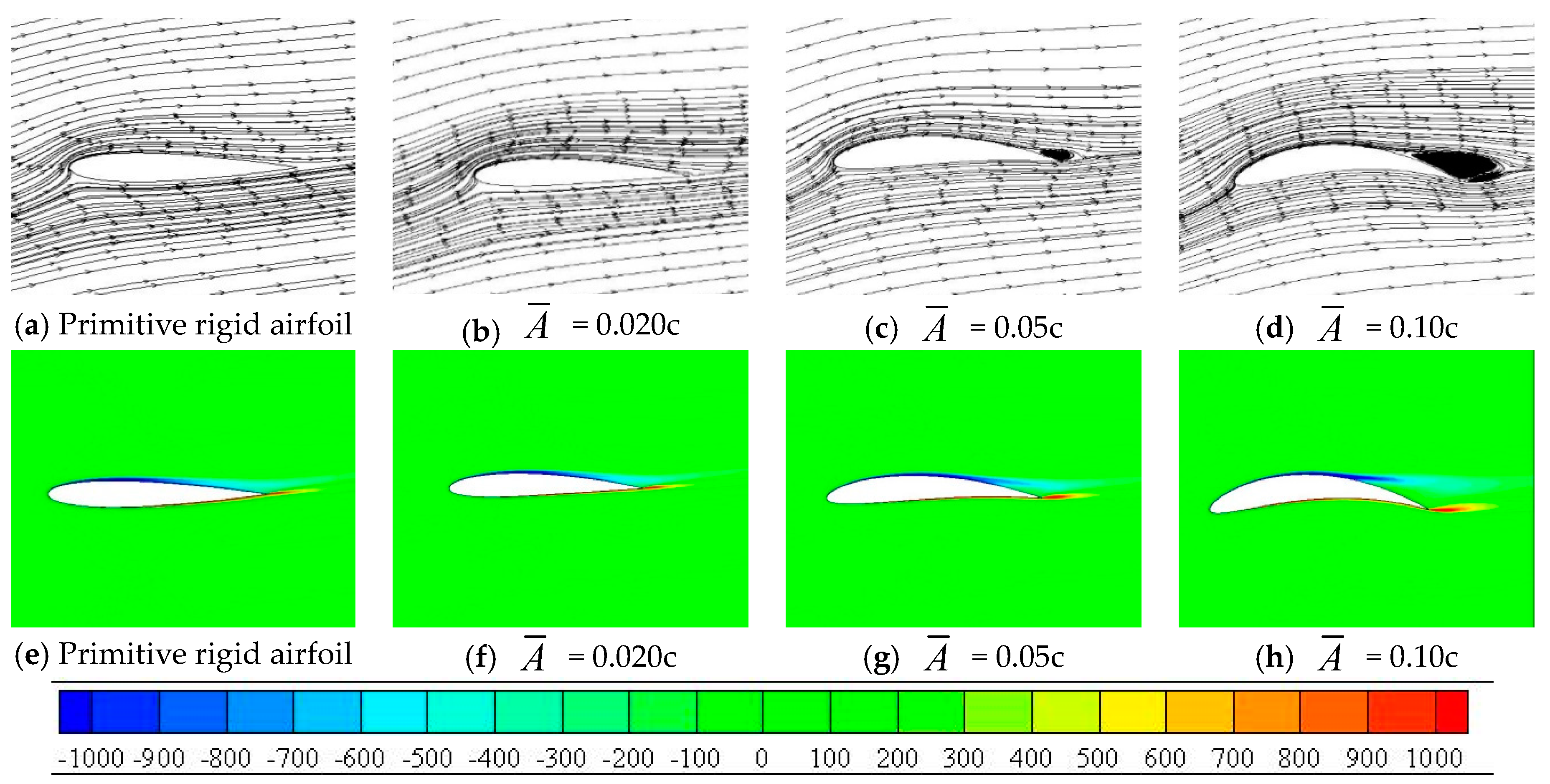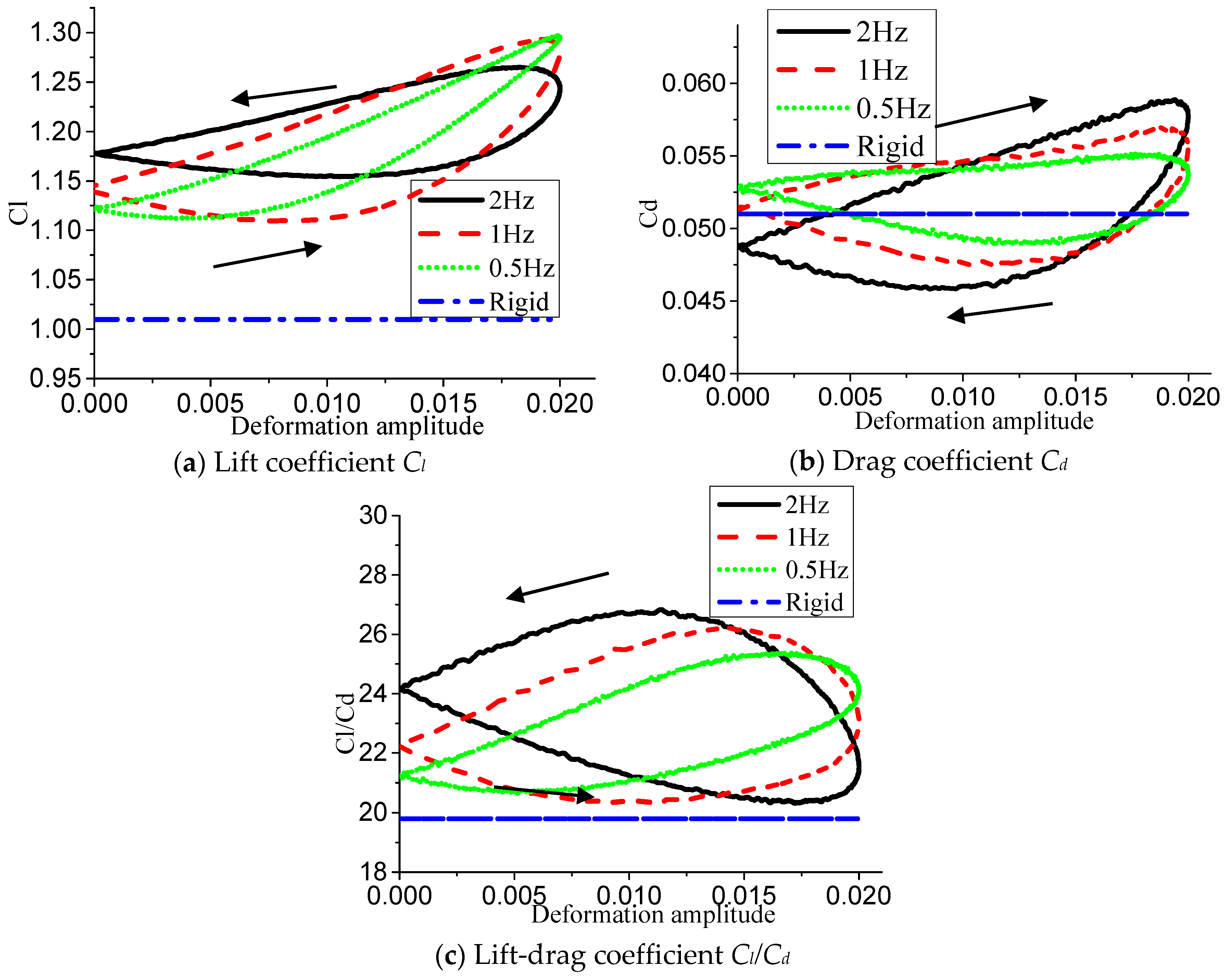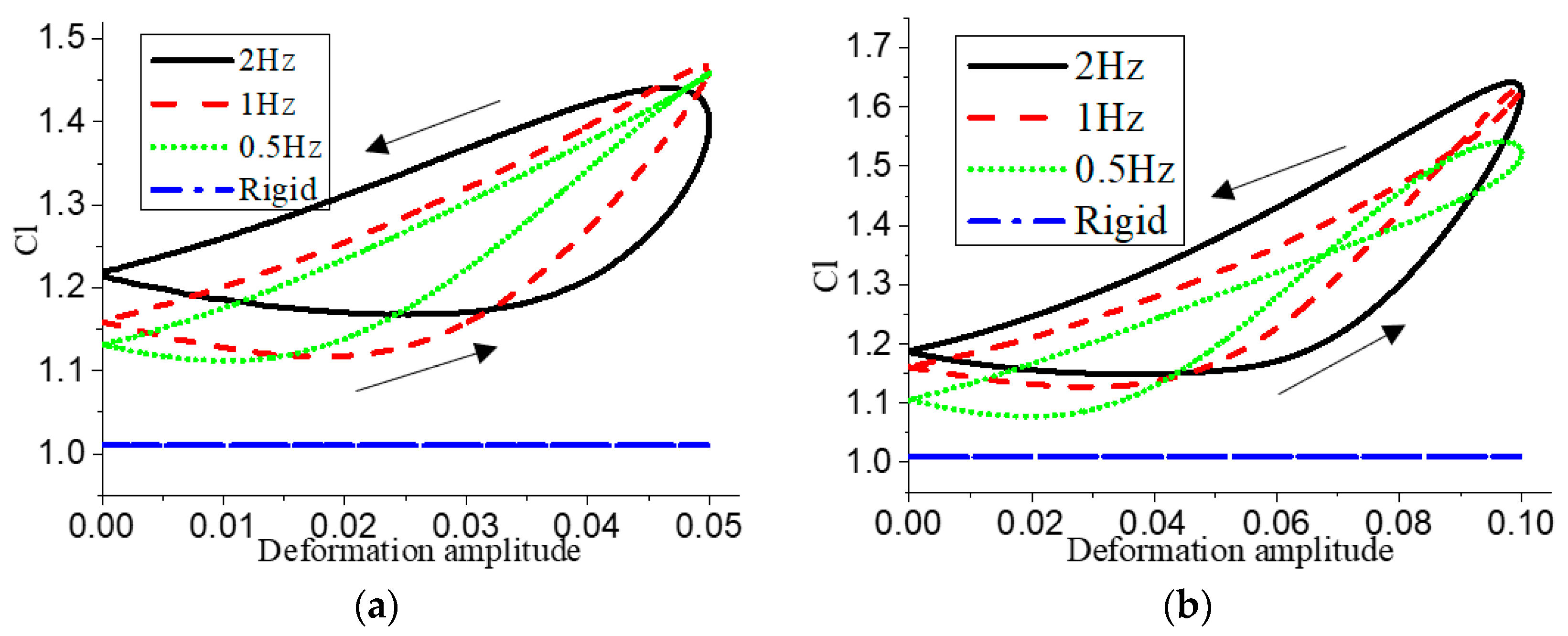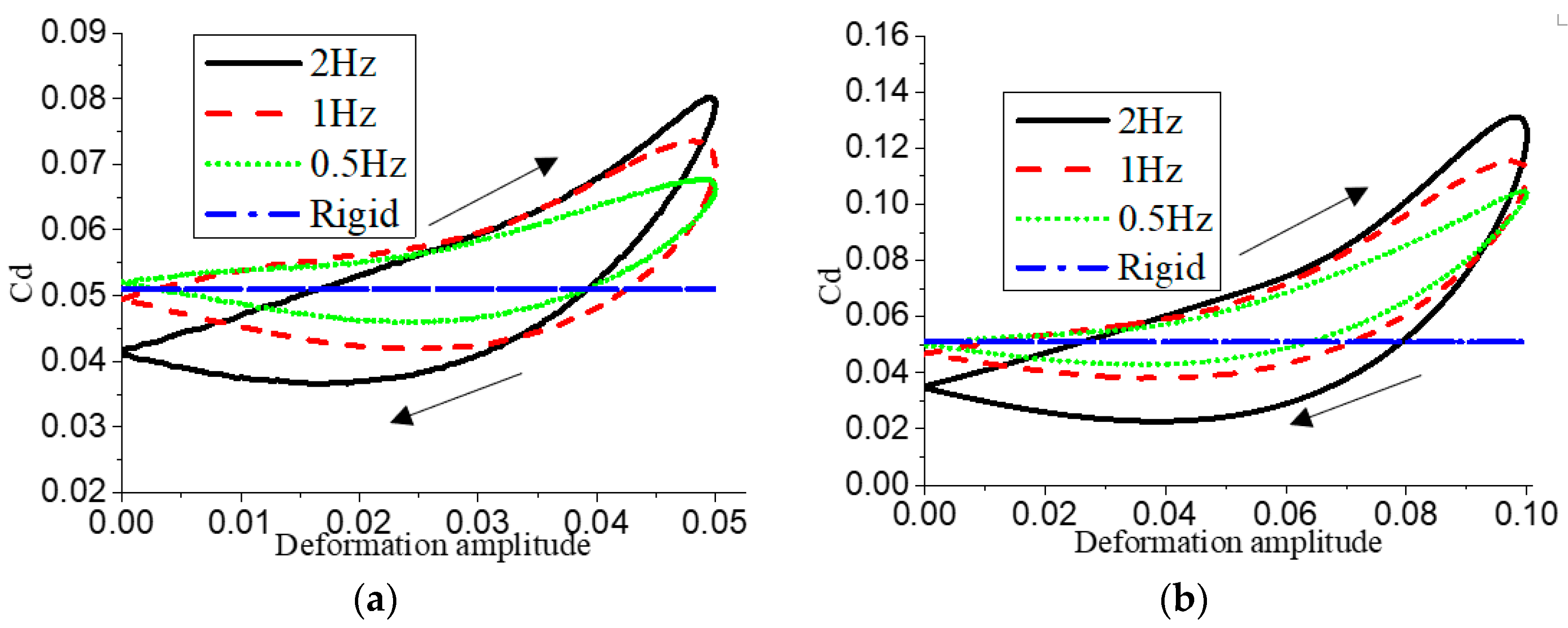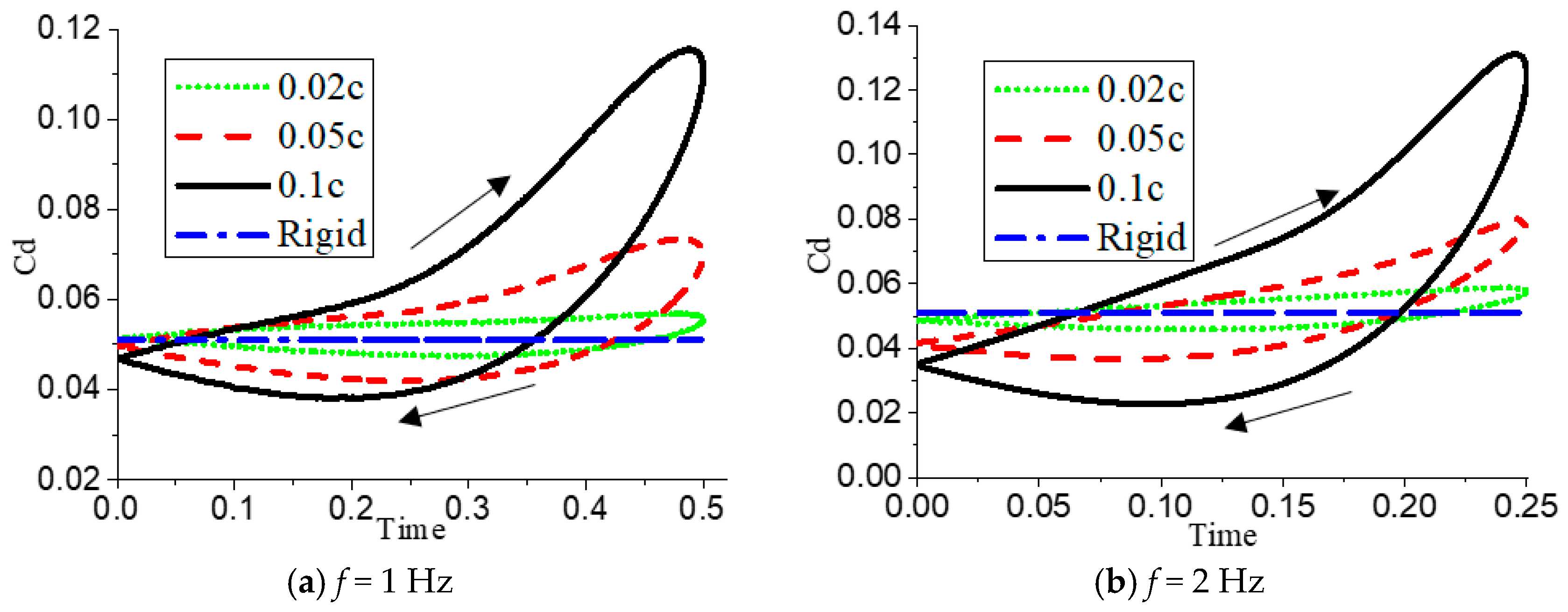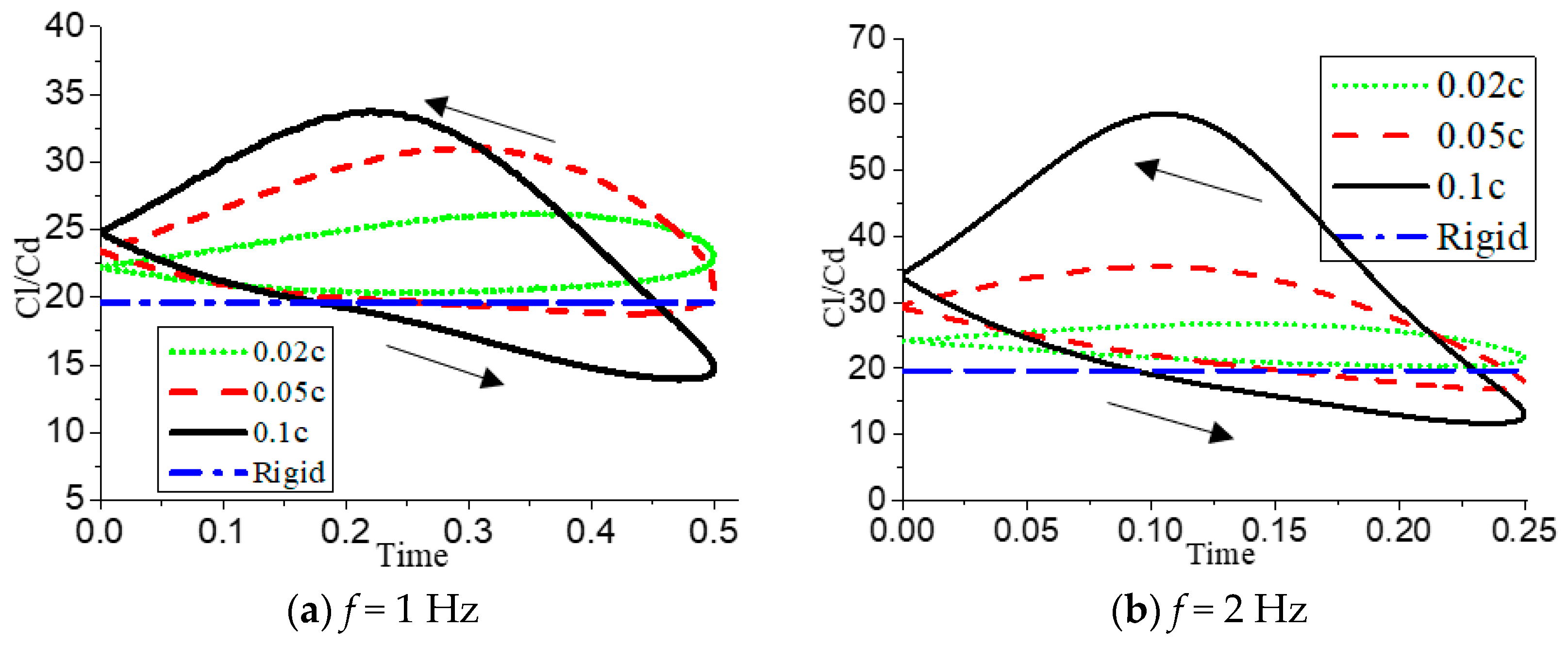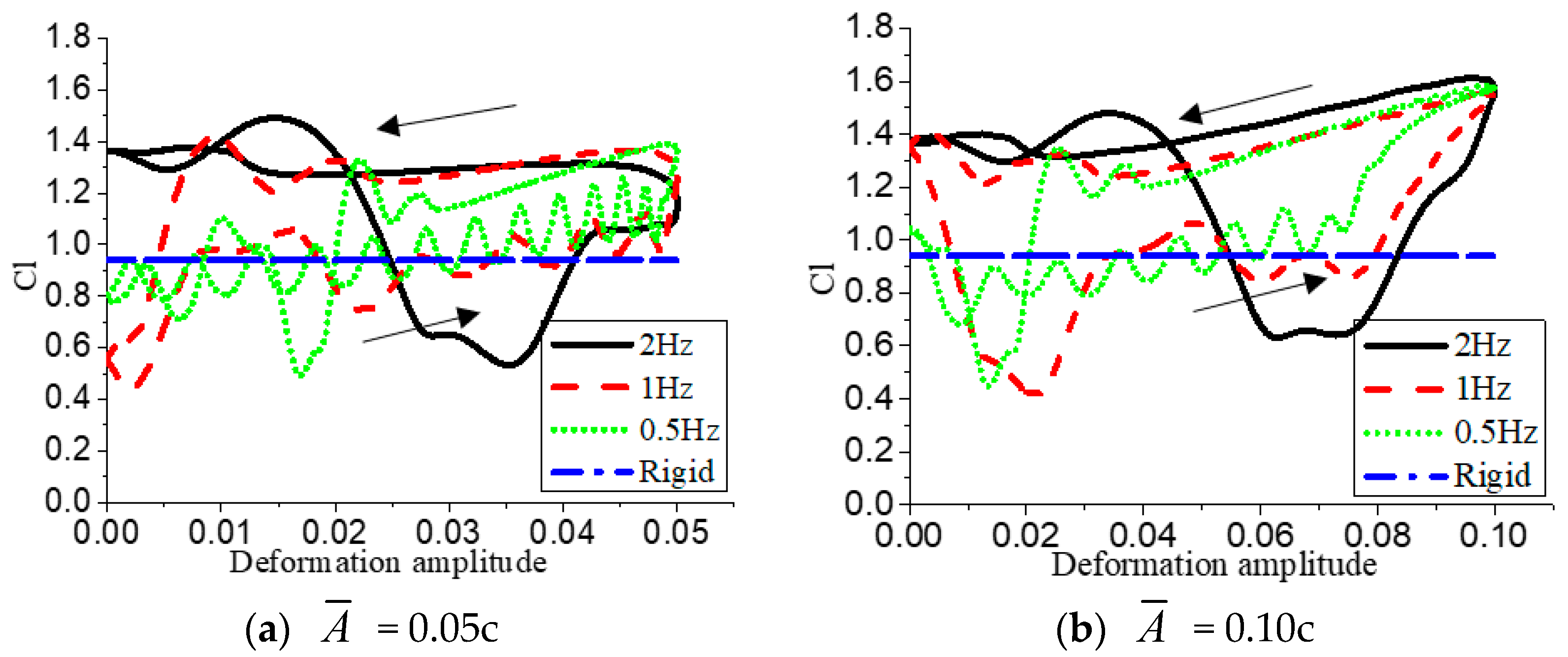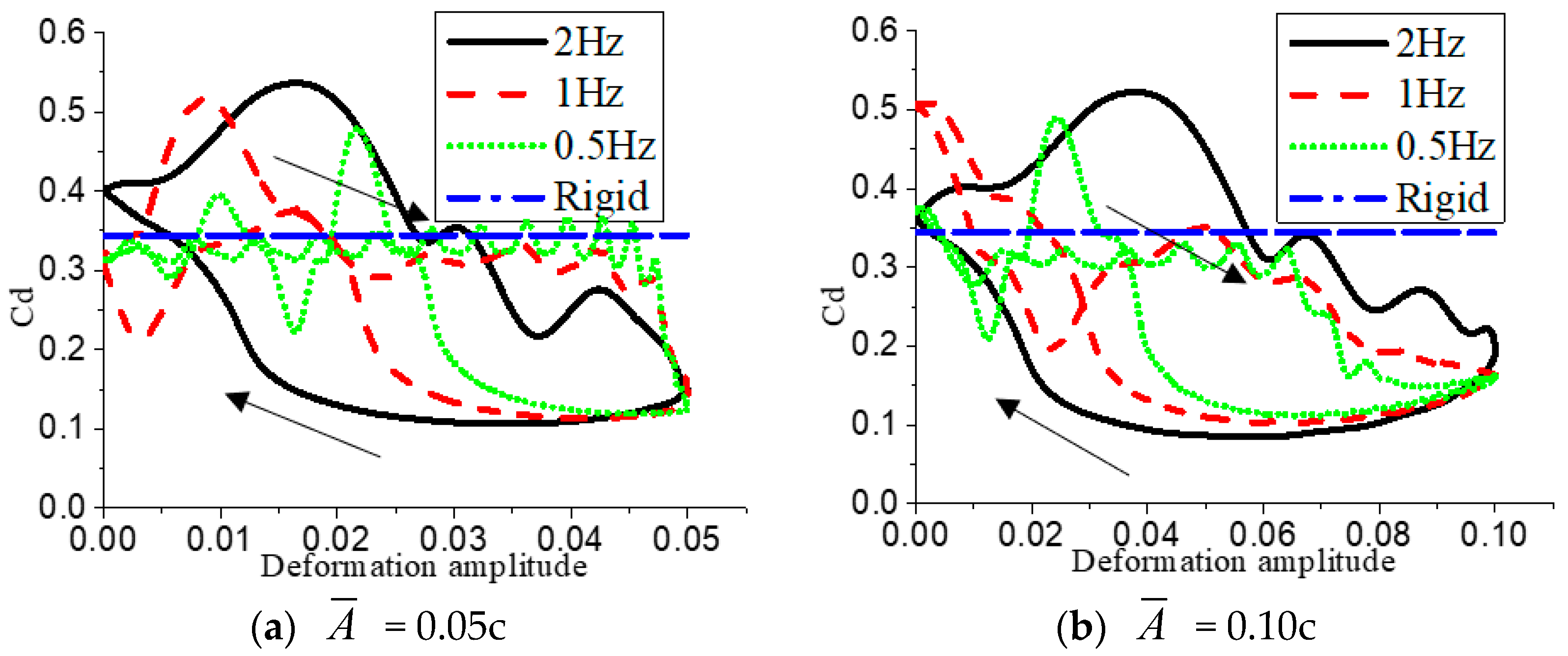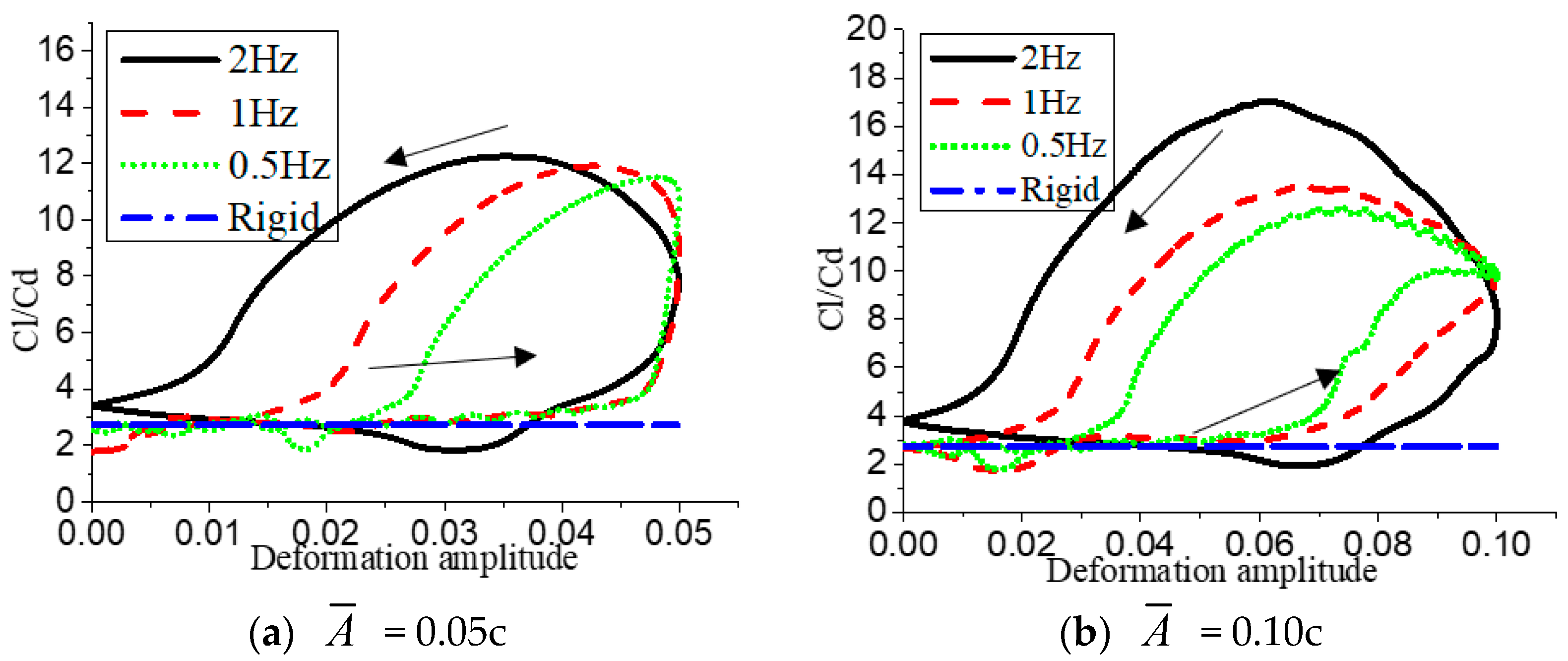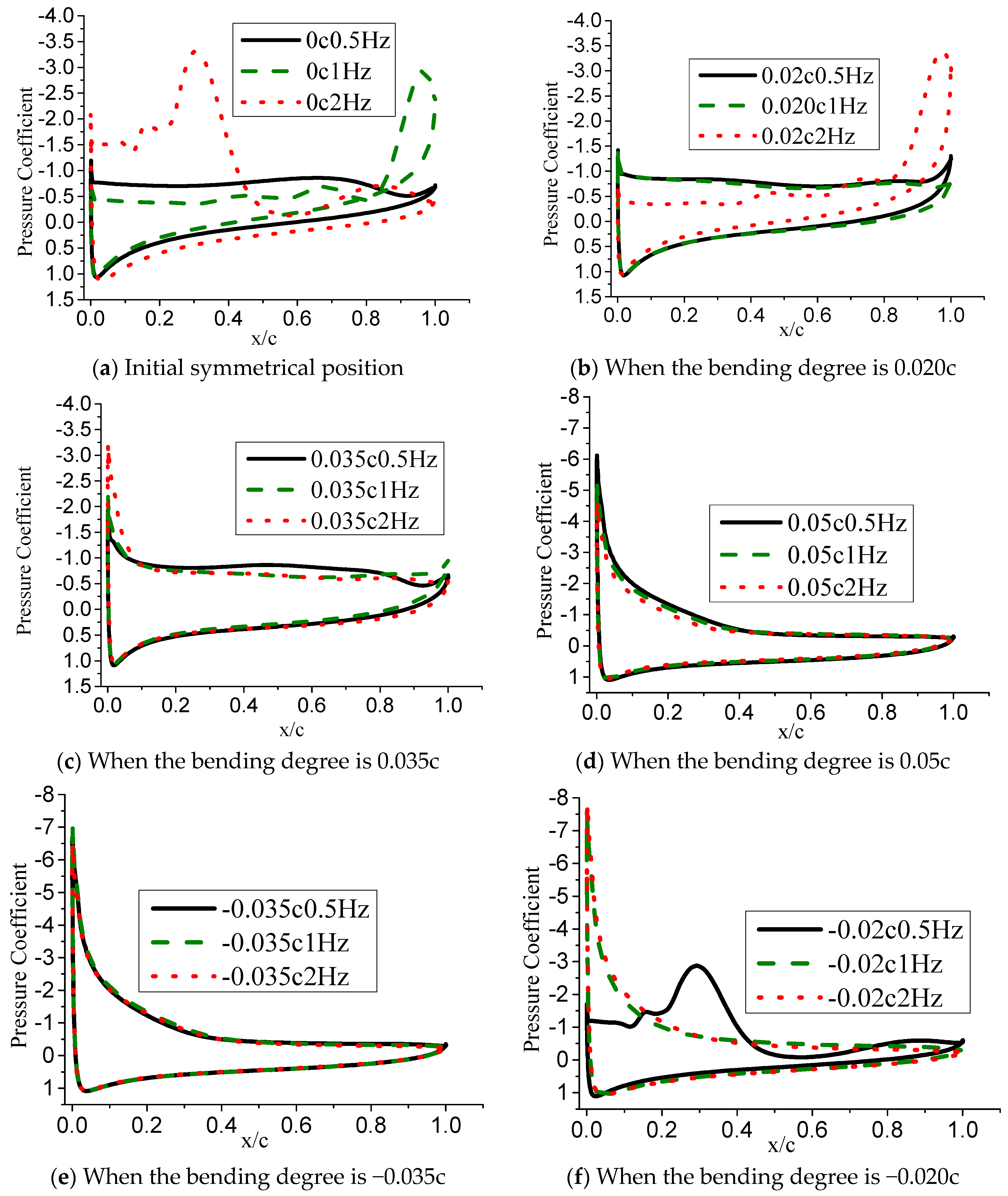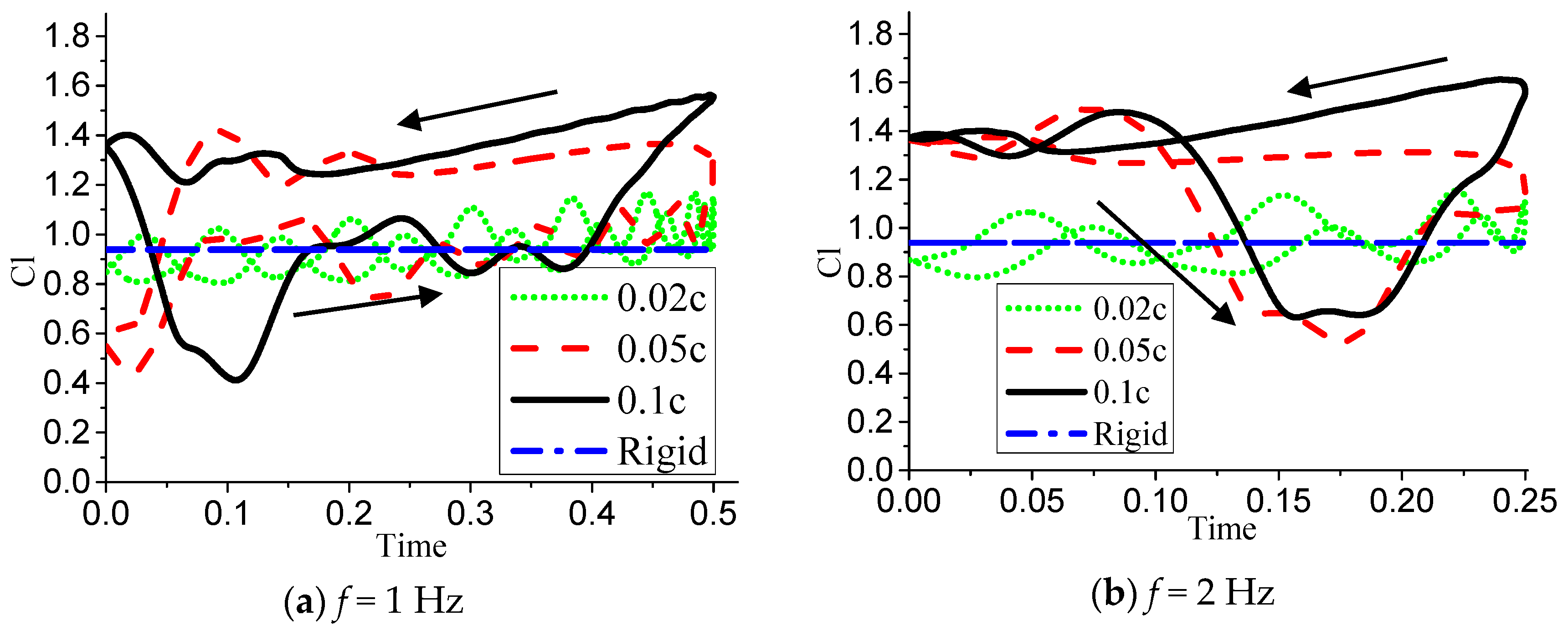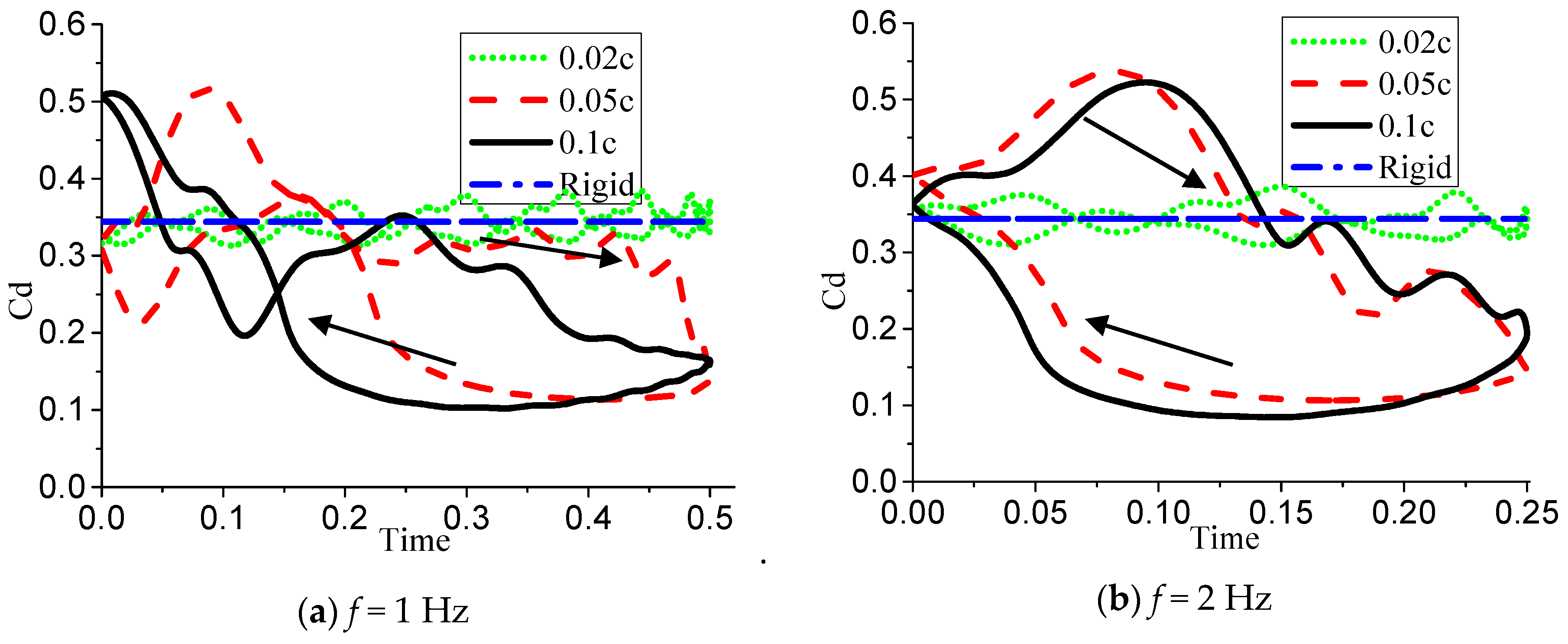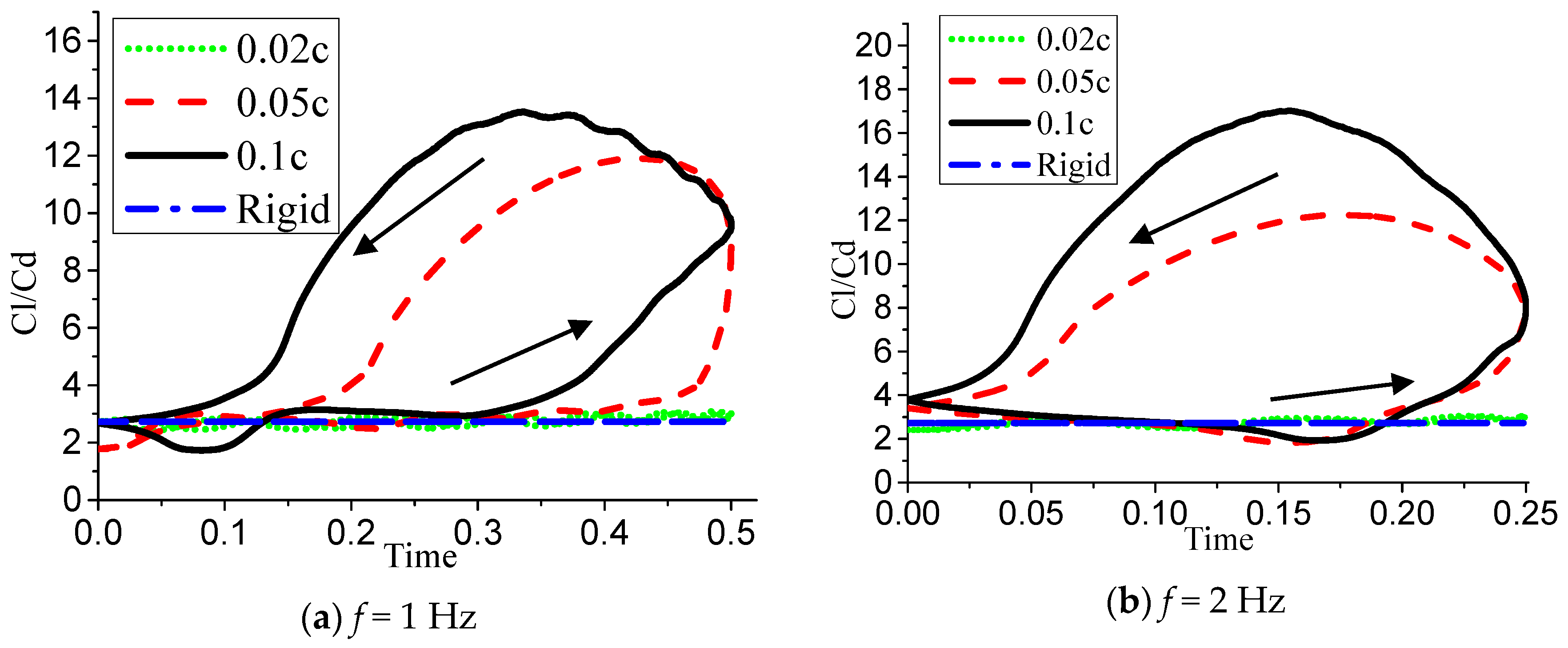The studying object in this paper is the airfoil NACA0012 with a chord length of 0.4 m. In a deformed period, the aerodynamic performance of the deformed blade is studied when it is deformed with the same thickness at different attack angles, different frequencies and different vibration amplitudes. In this paper, the angle of attack α is 10° (before stall angle of attack), 14° (shallow stall angle of attack) and 18° (deep stall angle of attack), the deformation frequency f is 2 Hz, 1 Hz, and 0.5 Hz, and the deformation amplitude is 0.020c, 0.05c, and 0.10c, respectively. The direction indicated by the arrow in the data diagram describes the change process of a period-center piston aerodynamic data when the airfoil starts to deform to the maximum deformation amplitude (deformation ascending) and when the airfoil returns to the initial shape (deformation descending) from the maximum deformation amplitude.
4.1. Active Deformed Airfoil at Attack Angle α = 10°
The influence law of the same deformation amplitude and different deformation frequencies on the aerodynamic performance of the actively deformed airfoil was analyzed when the angle of attack was 10°, that is, before stall.
Figure 6 shows the lift-drag coefficient and lift-drag ratio of the airfoil at different deformation frequencies when the deformation amplitude was 0.020c, and also gives the simulation results of the flow around the original NACA0012 rigid airfoil as a comparison. As can be seen from
Figure 6a, due to the generation of deformed movement, the lift coefficient of the deformed airfoil at three frequencies was greater than that of the rigid airfoil in a moving period, and the lift coefficient reached the maximum value when the deformation amplitude of the airfoil increased to 0.020c. However, the increase of deformation frequency has no significant effect on the maximum and minimum lift coefficient. With the increase of deformation frequency, the minimum value of the lift coefficient of the deformed airfoil is always higher than that of the original airfoil, and the more obvious the hysteresis of the lift coefficient, the larger the area enclosed by the hysteresis loop. As can be seen from the relationship between the drag coefficients in
Figure 6b, with the increase of deformation frequency, the drag coefficient at the maximum deformation amplitude was larger, and in the second half of the deformation downward, the drag coefficient was gradually lower than that of the rigid airfoil. Therefore, based on
Figure 6c of the lift-to-drag ratio relation, it can be seen that the lift-to-drag ratio was lower than that of the rigid airfoil in a larger range of deformed period after the airfoil changes camber, and the lift-to-drag ratio can be recovered and lifted when the airfoil deforms downward.
Figure 7,
Figure 8 and
Figure 9 show the changes in aerodynamic performance of the airfoil at deformation amplitudes of 0.05c and 0.10c. It can be seen that in the case of fixed deformation amplitude
, the deformation frequency
f had no obvious influence on the extreme value of the lift coefficient, and the area of the hysteresis loop also increased with the increase of
f. When
is 0.10c and
f is 0.5 Hz and 1Hz, respectively, the hysteresis loop of lift coefficient presents a horizontal “eight-shape”. In
Figure 8, the value of resistance coefficient still shows a similar change rule with 0.020c. The difference is that when the
is 0.10c, the deformation frequency is
f = 2 Hz, the drag coefficient of the airfoil is negative in the middle section of the downward deformation.
Figure 9b,c are lift-to-drag ratio graphs. Since it is difficult to directly represent infinity and infinitesimal values in the graph, the ordinate only takes the interval of −10,000 to 10,000. It can be seen that when
f is 2 Hz, the lift-drag ratio of the airfoil is relatively stable in the ascending process (① → ② → ③), but in the descending process (④ → ⑤ → ⑥ → ⑦ → ⑧), infinite values and infinitesimal values appear in the processes of ④ → ⑤ and ⑦ → ⑧, respectively. Here, it is explained that when the airfoil is in large deformation amplitude, only the deformation frequency needs to be high enough, and the airfoil will not generate resistance but generate thrust itself in a certain interval of deformation descending, thus forming a situation similar to flapping foil flapping to generate thrust. In addition, it can be inferred that if the deformation amplitude or frequency continues to increase, the thrust generation interval of the airfoil will gradually increase. However, the case of this airfoil obtaining thrust is beyond the scope of this article; thus, it will not be discussed much. From
Figure 9, it can be concluded that the lift-to-drag ratio of the airfoil decreases as the camber increases when the deformation goes up, and is lower than the lift-to-drag ratio of the rigid airfoil at the beginning of the deformation. Similarly, due to the decrease of the drag coefficient when the deformation goes down, the lift-to-drag ratio quickly recovers and shows a larger increase in the middle section of the downward movement.
In order to obtain the influence of deformation amplitude on the aerodynamic performance of airfoil more clearly, the lift-drag coefficient and lift-drag ratio diagrams of airfoil under the same deformation frequency
f = 0.5 Hz and different deformation amplitudes
are given below.
Figure 10 gives the graph under different deformation amplitudes when
f is 0.5 Hz. In
Figure 10a, it can be seen that when
increases, the value of the maximum lift coefficient also increases, and the maximum lift coefficient under the condition of
= 0.10c reaches 55.6% compared with that of the rigid airfoil. At the same time, because
α = 10° is the angle of attack before stall, the flow field of airfoil suction surface is relatively stable, and the flow field can be well recovered when the airfoil deforms from a period to the initial symmetric airfoil; thus, the initial value of the lift coefficient of the deformed airfoil is very close to that of the rigid airfoil. As can be seen in
Figure 10b, the maximum drag coefficient of the airfoil in a deformed period also increases with the increase of the deformation amplitude, and when
= 0.10c, the drag coefficient will increase sharply.
Figure 11,
Figure 12 and
Figure 13 show the relationship between the aerodynamic parameters corresponding to different deformation amplitudes under the condition that the deformation frequency
f is 1 Hz and 2 Hz, respectively. It can be seen in the lift coefficient relationship diagram of
Figure 11 that the same vibration frequency
f when the deformation amplitude
is increased, the lift coefficient of the airfoil in a deformation period is greater than that of the rigid airfoil. As the amplitude increases, the maximum lift coefficient value increases greatly.
Figure 12 shows the drag coefficient relationship. Similarly, as the amplitude
increases, the drag coefficient increases sharply. In addition, the area of the hysteresis loop of the drag coefficient increases with the increase of the amplitude. It can be seen from the graph of lift-resistance ratio of
Figure 13 that when
f = 1 Hz and
is 0.020c, the lift-to-drag ratio of the deformed airfoil is higher than that of the rigid airfoil during the whole deformation period, and the lift-to-drag ratio is improved nearly 25% in the downward stage of deformation. The airfoil can stably improve the aerodynamic performance under this deformation mode, and is also the best deformation mode under the 10° angle of attack.
The resistance coefficient value in
Figure 12b can be seen to increase with the rise of the deformation amplitude, and the resistance coefficient increases sharply when
reaches 0.10c. Therefore,
Figure 14 gives the instantaneous streamline diagram and instantaneous vorticity diagram of the original rigid airfoil and the airfoil at the moment when the airfoil deforms to a given maximum deformation amplitude under three deformation amplitudes. For the rigid airfoil,
Figure 14a, when the airfoil is at the stall angle of attack, the suction surface of flow field is appendage flow from the leading edge to the trailing edge, and the slender free shear layer on suction surface is extended from the leading edge to the trailing edge. It can be seen from the streamline diagram of
Figure 14b–d that due to the increase of the deformation amplitude of the active deformation of the airfoil, after reaching the given maximum deformation amplitude, separation bubbles of different sizes appear at the trailing edge of the airfoil. When
is 0.020c, the upper airfoil surface maintains a stable flow field like the rigid airfoil, and the boundary layer of suction surface does not separate. When the
increases to 0.05c, the boundary layer at the rear section of the airfoil gradually thickens near the trailing edge, pushing the main flow outward, the pressure gradually decreases, and the increase of the reverse pressure gradient causes the boundary layer flow to begin to separate and form vortex. With the
continued increase to 0.10c, the separation point of the airfoil suction surface continues to move forward, the pressure of the main flow and the vortex zone at the separation becomes lower, and a large-scale separation bubble has been formed at the trailing edge, resulting in the increase of differential pressure resistance.
4.2. Active Deformed Airfoil at Attack Angle α = 14°
When the angle of attack
α = 14°, it has exceeded the critical angle of attack and is in the light stall angle of attack range.
Figure 15 is a graph showing the aerodynamic parameters of an airfoil at three different deformation frequencies when the deformation amplitude is 0.020c. As can be seen from the lift coefficient diagram in
Figure 15a, under the condition of light stall angle of attack, the aerodynamic performance of the actively deformed airfoil shows obvious improvement. The lift coefficient value is increased by more than 10% over the rigid airfoil in the whole deformed period. The larger the deformation frequency is, the smaller the fluctuation range of the lift coefficient value is. In
Figure 15b, the airfoil resistance coefficient still increases with the increase of camber when the deformation goes up, and the maximum resistance coefficient value increases with the increase of
f. The larger
f when the deformation goes down, the more obvious the decrease of the resistance coefficient value is. As can be seen in
Figure 15, although the drag coefficient increases with the increase of deformation camber, the lift-drag ratio of the airfoil is still maintained above the lift-drag ratio of the rigid airfoil throughout the deformation period, and the maximum lift-drag ratio can be increased by about 25%.
Figure 16,
Figure 17 and
Figure 18 show the unsteady aerodynamic parameters at three deformation frequencies for deformation amplitudes of 0.05c and 0.10c. As can be seen in
Figure 16, the influence of the deformation frequency on the extreme value of airfoil lift coefficient is still not obvious, only slightly different at the initial stage of deformation, and the area of hysteresis loop also increases with the increase of frequency. The drag reduction effect of the actively deformed airfoil in
Figure 17 is still in the downward stage of airfoil deformation, and the drag reduction effect increases with the increase of
f. The best drag reduction effect can reach about 50%. Therefore, it can be seen in
Figure 18 that the lift-to-drag ratio has the maximum lift-to-drag ratio when the deformation goes down, and the lift-to-drag ratio is more obvious when the frequency
f = 2 Hz. In addition, when the airfoil is at
= 0.05c and
f = 0.5 Hz, the lift-to-drag ratio in one cycle of the actively deformed airfoil is improved compared with the rigid airfoil, and the maximum lift-to-drag ratio can be increased by about 25%.
It can be seen from
Figure 16a that the flow hysteresis effect produced by the airfoil during active deformation is closely related to the response time of its suction surface flow field structure. With the increase of
f, that is, the period time of airfoil deformation gradually shortens, its suction surface separation flow field structure cannot respond in time with the change of camber. Specifically, when
f = 0.5 Hz, the lift coefficient starts to increase at 30% of the given deformation amplitude when the airfoil deforms. When
f reaches 2 Hz, when the airfoil returns to the initial symmetric airfoil state and starts a new deformation period again, the lift coefficient increases only when the camber increases to 80% of the given deformation amplitude due to the existence of large separation bubbles at the trailing edge. Prior to this, the lift coefficient value is still slowly decreasing compared with the initial state.
Figure 19 shows the relationship between the unsteady aerodynamic parameters of the deformation frequency
f = 0.5 Hz and the different deformation amplitudes of the airfoil. As the amplitude
increases, the maximum lift coefficient of the airfoil gradually increases. During the initial deformation, the amplitude
has no obvious influence on the lift coefficient value, but when the deformation amplitude
reaches a larger value, its lifting capacity becomes more limited, and the lift coefficient curve presents a horizontal “eight-shape”. This is because when the airfoil deforms to the maximum deformation, its suction surface separation flow field structure has sufficient evolution time, resulting in large-sized separation bubbles at the trailing edge, and the airfoil lift coefficient value decreases with the recovery of camber at a smaller slope. Therefore, it can be seen in
Figure 19 that the drag coefficient at
= 0.10c increases sharply under the maximum deformation, and the numerical value increases twice as much as that of the rigid airfoil, while the lift-drag ratio is also lower than that of the rigid airfoil at the maximum deformation.
When
Figure 20,
Figure 21 and
Figure 22 show the lift resistance coefficient increases significantly when
f = 1 Hz and
f = 2 Hz, respectively, as the deformation amplitude
increases. When
= 0.10c, the drag coefficient also reaches the maximum camber, which results in a significantly lower lift-to-drag ratio than the rigid airfoil here. While
= 0.020c and
= 0.05c, it maintains the same or even higher lift-to-drag ratio than the rigid airfoil during one cycle of airfoil deformation.
4.3. Active Deformation Airfoil at 18° Angle of Attack
Figure 23 shows the relationship between unsteady aerodynamic parameters at different deformation frequencies
f at an angle of attack
α = 18° and a deformation amplitude
= 0.020c. At the angle of attack of deep stall, the flow field of the rigid airfoil suction surface starts to separate from the position of the leading edge point and form a large-scale separation bubble covering over the suction surface, while the small vortex at the trailing edge of the airfoil continuously falls off downstream. At this deformation amplitude, it can also be seen that the lift coefficient of the airfoil in a deformed period fluctuates regularly with the shedding of the vortex on the upper airfoil surface. The value fluctuates basically around the time-average lift coefficient of the rigid airfoil and increases when reaching the maximum camber. On the whole, at this angle of attack, the smaller deformation amplitude is not enough to help the fluid to resist the reverse pressure gradient generated by the upper airfoil surface and to reduce the size of the separation bubble; thus, the aerodynamic performance in a period of active airfoil deformation is difficult to significantly improve.
As shown in
Figure 24, different deformation frequencies
f have no obvious influence on the variation interval of airfoil lift coefficient value, and the aerodynamic performance of the airfoil is effectively and stably improved in the deformation descending stage after the maximum camber. However, due to the difference of
f, the lift coefficient of airfoils will suddenly drop at a certain moment of deformation. From
Figure 24a, it can be seen that when
f = 0.5 Hz, the lift coefficient of the airfoil plummets when the deformation goes down to 40% of the maximum deformation amplitude. When the frequency increases to 1 Hz, the plummeting phenomenon is postponed to 10% of the maximum deformation amplitude when the deformation goes down, while when the frequency
f = 2 Hz, the deformation goes up to 40% of the maximum deformation amplitude. Similarly, this rule is also showed in
Figure 24b, and due to the increase of
, the interval for stable improvement of aerodynamic performance of airfoil during deformation downward is widened. As shown in
Figure 25, the variation of drag coefficient is quite different from the previous working conditions. Under the attack angle of deep stall, the active deformation of airfoil can produce drag reduction effect in most areas. Under the conditions of
= 0.05c and
= 0.10c, the drag coefficient is almost lower than that of the rigid airfoil in the whole section when the airfoil deforms downward, and the drag reduction effect of inside reaches about 50% in the specific section under each
f. Therefore, it can be seen from
Figure 26 that the lift-drag ratio of the airfoil after active deformation is basically the same as that of the rigid airfoil when the airfoil is deformed upward, and the entire interval from the maximum deformation amplitude to the deformation downward to the initial state is significantly improved, which is the optimization effect brought by the increase of lift and the decrease of resistance at the same time.
Figure 27,
Figure 28,
Figure 29,
Figure 30,
Figure 31 and
Figure 32 show the instantaneous vorticity diagram, when the airfoil deformation amplitude is 0.05c; the deformation goes up to 0.020c, 0.035c, 0.5c, and the deformation goes down to 0.035c, 0.020c in the initial state at three different deformation frequencies. In order to facilitate the distinction, the bending value when the deformation descends is prefixed with a minus sign. As shown in
Figure 27a, at the initial deformation of the airfoil with
f = 2 Hz, the free shear layer separated from the front edge point of the wall starts to generate a medium-scale vortex structure rolling downstream, and the free shear layer on the blade leading edge surface is rolled up to form a small-scale vortex structure and develops downstream along the upper surface of the airfoil. At this time, the lift coefficient value of the airfoil can still be stably increased. In both papers [
22,
23,
24], the internal physical mechanism of active vibration wall that enhances the anti-separation ability of the fluid on airfoil surface is discussed. When the airfoil deforms to
Figure 28a, the lift coefficient starts to decrease when the free shear layer develops to the middle and rear sections of the airfoil. Comparing with
Figure 24a, it can be seen that the lift coefficient value of the airfoil at the initial deformation has been significantly reduced when
f = 1 Hz. At this time, it can be seen from
Figure 27b that the counterclockwise free shear layer rolled up by the upper surface has developed to the middle and rear sections, and the airflow at the trailing edge has rolled up a large-sized secondary separation vortex from the lower surface.
As shown in
Figure 29 and
Figure 32, when the airfoil reaches the maximum camber of deformation amplitude
= 0.05c, the separation points of the airfoil at three different frequencies
f coincide, and the size of the surface backflow region of the upper airfoil is similar. Thus, the lift coefficient increases to a similar degree. When the deformation descends, it can be seen that due to the difference of deformation frequency, the response time of the flow field structure of the upper surface shows obvious difference. When the airfoil deformation descends to 0.020c under the conditions of
f = 2 Hz and 1 Hz, the scale of the main separation vortex of the upper surface still does not obviously increase, and the separation zone appears between the shear layers with different rotation degrees of the leading edge and the trailing edge. However, when
f = 0.5 Hz, the flow field structure on the airfoil starts to deteriorate obviously, and the lift coefficient reaches the valley state.
Figure 33 shows a comparison of the surface pressure coefficients when the airfoil is deformed to different cambers at different frequencies
f when the airfoil deformation amplitude is
= 0.05c. As shown in
Figure 33a, when
f = 2 Hz, the pressure coefficient pulsation appears on the upper surface of the airfoil, reaching the peak value of the pressure difference between the upper and lower surfaces at 0.3 times chord length. At this time, the area enclosed by the pressure coefficient curve is larger than that enclosed by other deformation frequencies, and the corresponding lift coefficient value is the largest. When
f = 1 Hz, a large-scale separation vortex structure is generated at the trailing edge of the airfoil and then falls off, thus, the pressure coefficient pulsation occurs near the trailing edge, and the rest changes little. The curve surrounded by the pressure coefficient is reduced, and the lift coefficient is in the valley corresponding to
Figure 24a. In
Figure 33b, when
f = 2 Hz, since the airflow on the lower surface of the airfoil rolls up the secondary separation vortex from the upper side, the pulsation also occurs at the trailing edge, and the airfoil lift coefficient value starts to decrease. As shown in
Figure 33f, when the airfoil
f = 0.5 Hz is deformed down to 0.02 c, pressure pulsation occurs on the upper surface, and the airfoil lift coefficient suddenly drops at this stage.
Figure 34 shows the relationship between unsteady aerodynamic parameters of airfoil under different deformation amplitudes at deformation frequency
f = 0.5 Hz. It can be seen that the maximum lift coefficient value still increases with the increase of the deformation amplitude, and the lift coefficient of the upward stage of the airfoil deformation exhibits periodic fluctuation due to the separation of the separation bubble. For
= 0.05c, when the airfoil deforms to the maximum camber, the flow field changes, and the flow starts to move backward from the separation point of the leading edge in the large separation state, and then gradually stabilizes. At this time, the lift coefficient value of the airfoil is improved. When
= 0.10c, because the maximum camber value increases, the vortex region of the airfoil suction surface is suppressed faster, so the lift coefficient starts to increase earlier. Under these two deformation amplitudes, the lift coefficient values begin to plummet after two unstable peaks appear when the deformation descends, and the larger the value of
is, the closer the plummet point is to the termination point of a deformation period. In addition, as can be seen in
Figure 34b, the sharp drop point of the lift coefficient value is accompanied by the occurrence of the peak of the drag coefficient. Due to the small deformation frequency, the flow field of the airfoil suction surface has sufficient response time, and the airfoil lift-to-drag ratio is limited in a range in which the deformation period can be improved.
Figure 35,
Figure 36 and
Figure 37 show the unsteady aerodynamic parameters of different deformation amplitudes when the airfoil deformation frequency
f = 1 Hz and 2 Hz. When
f = 1 Hz, the variation law of the lift coefficient is basically similar to that at 0.5 Hz. Along with the increase in frequency, the airfoil sudden drop point continues to approach the end point of the downward deformation. When
= 0.10c, the sharp drop point appears at the starting point of active airfoil deformation. As the frequency
f continues to increase to 2 Hz, the airfoil can be stably lifted in the entire downward deformation interval, and the large-scale separation bubble of suction surface in this interval is effectively suppressed. At this time, the flow field has obvious hysteresis phenomenon, and the sharp drop point of lift coefficient does not appear until the airfoil is deformed upward. The drag coefficient is still accompanied by a sudden drop in the lift coefficient, which produces a peak of the drag coefficient. As the lift-to-drag ratio increases by
, the range that can be increased is greater, and the lifting effect is more significant.



